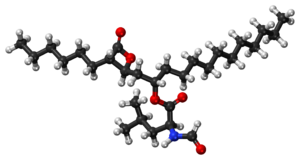
Back أورليستات Arabic اورليستات ARZ ارلیستات AZB Orlistat Catalan Orlistat Welsh Orlistat Danish Orlistat German Orlistat Spanish ارلیستات Persian Orlistaatti Finnish
 | |
 | |
| Clinical data | |
|---|---|
| Trade names | Xenical, Alli |
| Other names | tetrahydrolipstatin |
| AHFS/Drugs.com | Monograph |
| MedlinePlus | a601244 |
| License data | |
| Pregnancy category |
|
| Routes of administration | By mouth |
| ATC code | |
| Legal status | |
| Legal status | |
| Pharmacokinetic data | |
| Bioavailability | Negligible[8] |
| Protein binding | >99% |
| Metabolism | In the GI tract |
| Elimination half-life | 1 to 2 hours |
| Excretion | Fecal |
| Identifiers | |
| |
| CAS Number | |
| PubChem CID | |
| IUPHAR/BPS | |
| DrugBank | |
| ChemSpider | |
| UNII | |
| KEGG | |
| ChEBI | |
| ChEMBL | |
| CompTox Dashboard (EPA) | |
| ECHA InfoCard | 100.167.400 |
| Chemical and physical data | |
| Formula | C29H53NO5 |
| Molar mass | 495.745 g·mol−1 |
| 3D model (JSmol) | |
| |
| |
| | |
Orlistat, sold under the brand name Xenical among others, is a medication used to treat obesity. Its primary function is preventing the absorption of fats from the human diet by acting as a lipase inhibitor, thereby reducing caloric intake. It is intended for use in conjunction with a healthcare provider-supervised reduced-calorie diet.[4]
Orlistat is the saturated derivative of lipstatin, a potent natural inhibitor of pancreatic lipases isolated from the bacterium Streptomyces toxytricini.[9] However, due to its relative simplicity and stability, orlistat was chosen over lipstatin for development as an anti-obesity drug.[10]
The effectiveness of orlistat in promoting weight loss is definite but modest. Pooled data from clinical trials suggest that people given orlistat in addition to lifestyle modifications, such as diet and exercise, lose about 2–3 kilograms (4–7 lb) more than those not taking the drug over the course of a year.[11] Orlistat also modestly reduces blood pressure and appears to prevent the onset of type 2 diabetes, whether from the weight loss itself or other effects. It reduces the incidence of diabetes type II in people who are obese around the same amount that lifestyle changes do.[12]
Benefits aside, however, orlistat is noted for its gastrointestinal side effects (sometimes referred to as treatment effects), which can include steatorrhea (oily, loose stools). They decrease with time, however, and are the most frequently reported adverse effects of the drug.[4] In Australia, the United States and the European Union, orlistat is available for sale without a prescription.[13] Over-the-counter approval was controversial in the United States, with consumer advocacy group Public Citizen repeatedly opposing it on safety and efficacy grounds.[14] Generic formulations of orlistat are available in some countries. In Australia it has been listed as an S3 medication, available from a pharmacist without a prescription, since 2000.[15]
- ^ "Xenical 120 mg hard capsules - Summary of Product Characteristics (SmPC)". (emc). 18 May 2017. Archived from the original on 8 March 2022. Retrieved 19 September 2022.
- ^ "Beacita 120mg Capsules, hard - Summary of Product Characteristics (SmPC)". (emc). 11 November 2020. Archived from the original on 1 July 2022. Retrieved 19 September 2022.
- ^ "alli 60 mg hard capsules - Summary of Product Characteristics (SmPC)". (emc). 11 June 2021. Archived from the original on 18 January 2022. Retrieved 19 September 2022.
- ^ a b c "Xenical- orlistat capsule". DailyMed. 9 December 2021. Archived from the original on 17 July 2022. Retrieved 19 September 2022.
- ^ "Alli- orlistat capsule". DailyMed. 9 November 2020. Archived from the original on 30 November 2021. Retrieved 19 September 2022.
- ^ "Xenical EPAR". European Medicines Agency. 17 September 2018. Archived from the original on 15 April 2021. Retrieved 20 September 2022.
- ^ "Alli EPAR". European Medicines Agency. 17 September 2018. Archived from the original on 23 January 2022. Retrieved 20 September 2022.
- ^ Zhi J, Melia AT, Eggers H, Joly R, Patel IH (November 1995). "Review of limited systemic absorption of orlistat, a lipase inhibitor, in healthy human volunteers". Journal of Clinical Pharmacology. 35 (11): 1103–1108. doi:10.1002/j.1552-4604.1995.tb04034.x. PMID 8626884. S2CID 23618845.
- ^ Barbier P, Schneider F (1987). "Syntheses of tetrahydrolipstatin and absolute configuration of tetrahydrolipstatin and lipstatin". Helvetica Chimica Acta. 70 (1): 196–202. doi:10.1002/hlca.19870700124.
- ^ Pommier A, Pons M, Kocienski P (1995). "The first total synthesis of (−)-lipstatin". Journal of Organic Chemistry. 60 (22): 7334–7339. doi:10.1021/jo00127a045.
- ^ Padwal R, Li SK, Lau DC (2004). Padwal RS (ed.). "Long-term pharmacotherapy for obesity and overweight". The Cochrane Database of Systematic Reviews. 2003 (3): CD004094. doi:10.1002/14651858.CD004094.pub2. PMC 8078201. PMID 15266516.
- ^ Gillies CL, Abrams KR, Lambert PC, Cooper NJ, Sutton AJ, Hsu RT, Khunti K (February 2007). "Pharmacological and lifestyle interventions to prevent or delay type 2 diabetes in people with impaired glucose tolerance: systematic review and meta-analysis". BMJ. 334 (7588): 299. doi:10.1136/bmj.39063.689375.55. PMC 1796695. PMID 17237299.
- ^ "POISONS STANDARD JUNE 2017". Federal Register of Legislation. Therapeutic Goods Administration. June 2017. Archived from the original on 13 December 2020. Retrieved 18 August 2017.
- ^ Cite error: The named reference
WP2was invoked but never defined (see the help page). - ^ Cite error: The named reference
TGAauthwas invoked but never defined (see the help page).
© MMXXIII Rich X Search. We shall prevail. All rights reserved. Rich X Search